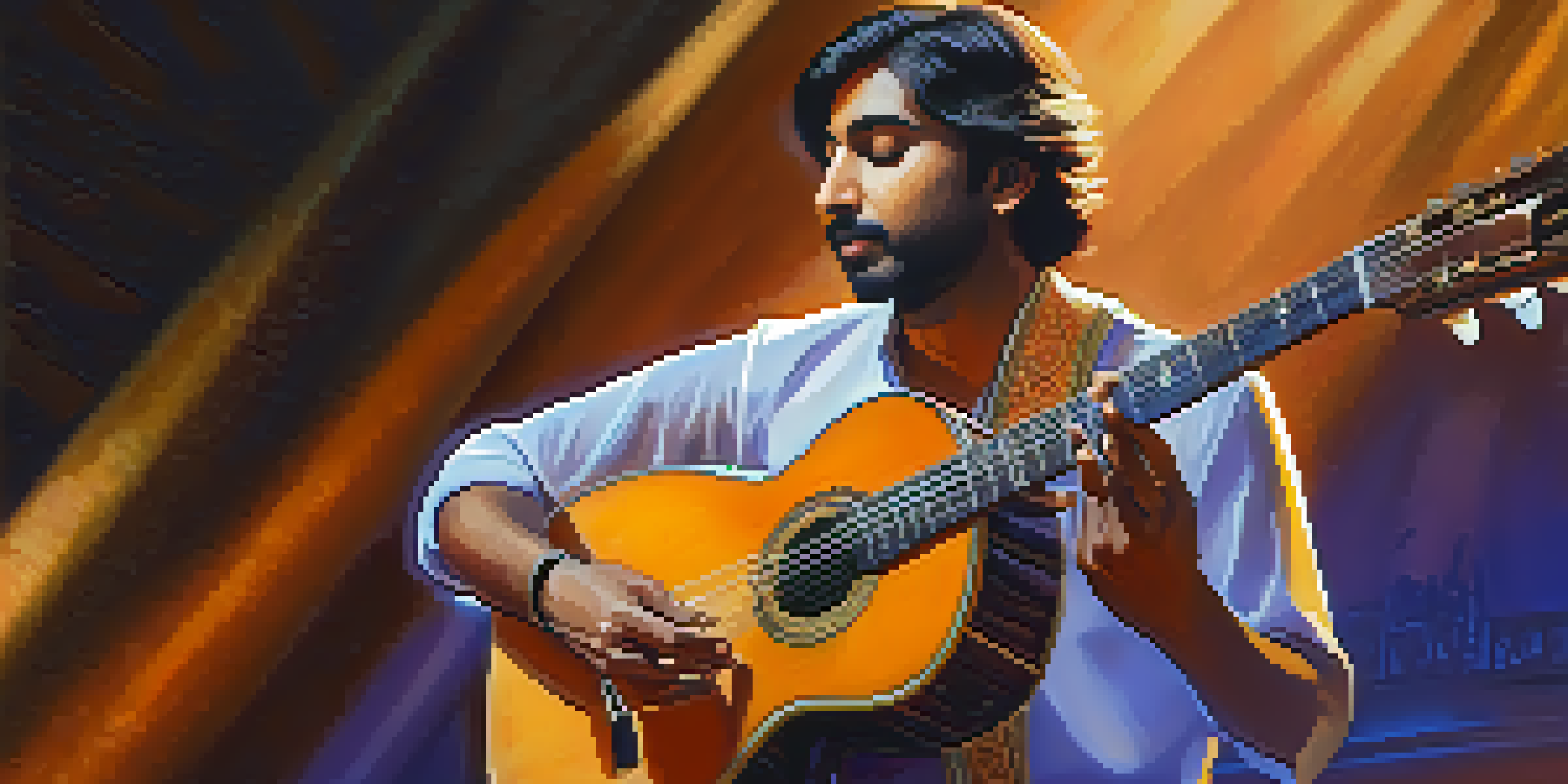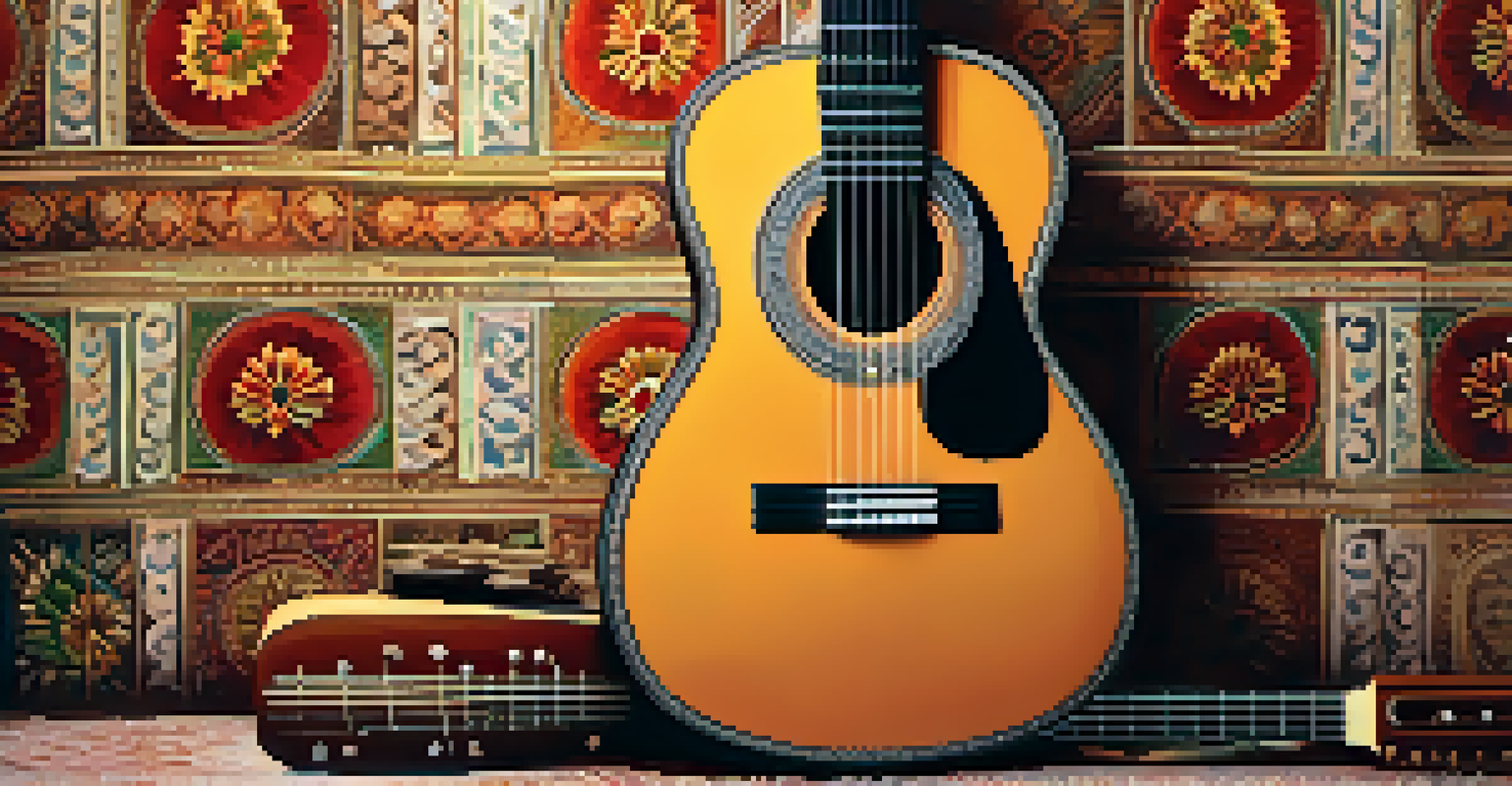Indian Classical Guitar: Fusion of Tradition and Modernity

The Roots of Indian Classical Guitar in Tradition
The Indian classical guitar has its roots deeply entwined with traditional Indian music. Originating from the rich history of stringed instruments in India, the guitar adapted to incorporate classical ragas and talas, creating a unique soundscape. Musicians began to explore the guitar's potential, blending the intricate patterns of Indian music with the instrument's versatility.
Music is the universal language of mankind.
Traditionally, instruments like the sitar and veena dominated the Indian classical scene. However, the guitar emerged as a modern alternative, appealing to a broader audience while still respecting its classical origins. This transition wasn't just about the instrument itself, but also about the new ways musicians began interpreting and performing Indian classical music.
As artists started experimenting, the guitar became a bridge connecting classical techniques with contemporary styles. This fusion opened up an exciting realm of possibilities, allowing musicians to express age-old sentiments through a new medium.
Key Features of Indian Classical Guitar Playing
Playing the Indian classical guitar involves unique techniques that echo traditional methods. Techniques such as slides, bends, and intricate finger styles are common, reflecting the nuances of Indian classical music. This approach gives the guitar its distinctive voice, setting it apart from other Western guitar styles.

Another essential element is the use of microtones, or shrutis, which are smaller than the semitones found in Western music. Musicians must develop a keen ear to master these subtleties, allowing them to convey emotions and expressions that are intrinsic to Indian classical music. This adds a layer of complexity and richness to the sound.
Fusion Expands Indian Guitar's Reach
The Indian classical guitar has evolved by blending traditional melodies with modern genres, creating innovative sounds that resonate with diverse audiences.
Moreover, the interplay between melody and rhythm is vital. Musicians often engage in a dialogue between the guitar and accompanying instruments or vocalists, creating a dynamic and engaging performance that captivates audiences.
The Role of Fusion in Modern Indian Music
Fusion music has become a significant trend in India's contemporary music scene, and the Indian classical guitar plays a crucial role. By blending various genres such as jazz, rock, and folk with traditional Indian melodies, artists are crafting innovative sounds that resonate with diverse audiences. This cross-pollination of styles enriches the musical landscape.
The guitar is a miniature orchestra in itself.
For instance, collaborations between classical guitarists and musicians from different genres have led to groundbreaking compositions. These partnerships often result in unique performances that celebrate both traditional and modern elements, showcasing the versatility of the guitar. It's a beautiful reminder of how music can transcend boundaries and connect people.
Furthermore, fusion allows for greater experimentation, encouraging musicians to push their creative limits. This experimentation leads to fresh interpretations of classical pieces, making them accessible to younger audiences who might not otherwise engage with traditional music.
Prominent Indian Classical Guitarists to Know
Several talented musicians have embraced the Indian classical guitar, each bringing their unique flair to the instrument. One notable figure is Debashish Bhattacharya, who is known for his innovative techniques and contributions to the genre. His mastery of the guitar has earned him acclaim not only in India but also on international stages.
Another prominent artist is Prasanna, who skillfully merges Indian classical with jazz and contemporary music. His ability to seamlessly integrate different styles has made him a sought-after collaborator and performer. Prasanna's work exemplifies the potential of the guitar to transcend genres while honoring its roots.
Technology Enhances Musical Expression
Advancements in technology, such as online platforms and sound tools, allow musicians to share their work globally and experiment with new soundscapes.
These musicians, among others, continue to inspire the next generation of guitarists. Their dedication to exploring the instrument's possibilities ensures that the Indian classical guitar remains a vibrant and evolving part of the musical tapestry.
The Impact of Technology on Indian Classical Guitar
In today's digital age, technology plays a pivotal role in the evolution of the Indian classical guitar. With the advent of recording software and online platforms, musicians can share their work with a global audience, transcending geographical limitations. This accessibility has allowed for greater collaboration and exchange of ideas among artists.
Moreover, tools like loop pedals and effects processors enable musicians to experiment with sound in ways that were previously unimaginable. By layering sounds and creating complex harmonies, guitarists can develop their unique soundscapes while remaining rooted in tradition. This technological integration enhances the overall musical experience.
The online presence of guitarists has also fostered a community of learners and enthusiasts. Tutorials, workshops, and live performances streamed online allow aspiring musicians to learn from the masters, ensuring that the techniques and traditions of Indian classical guitar continue to thrive.
Challenges Faced by Indian Classical Guitarists
Despite its growing popularity, Indian classical guitarists face unique challenges in their musical journey. One significant hurdle is the struggle for recognition within a predominantly traditional music landscape. While the guitar's versatility is celebrated, it can sometimes be overshadowed by more established instruments like the sitar and tabla.
Additionally, the complexity of Indian classical music can be daunting for new guitarists. Mastering the intricate techniques and understanding the theoretical aspects require dedication and practice. Many musicians must navigate this steep learning curve to truly express their artistry through the guitar.
Challenges in Gaining Recognition
Despite its growing popularity, Indian classical guitarists often struggle for recognition in a music landscape dominated by more traditional instruments.
Lastly, the fusion genre can present its own set of challenges, such as balancing traditional elements with modern influences. Guitarists often grapple with the question of authenticity and how to honor their roots while exploring new musical territories. This ongoing negotiation shapes their artistic identities and influences their creative choices.
The Future of Indian Classical Guitar: A Promising Horizon
The future of the Indian classical guitar looks bright as more musicians continue to embrace its potential. With an ever-expanding audience for fusion music, there is significant room for growth and exploration. Emerging artists are eager to experiment with new sounds and styles, breathing fresh life into the genre.
Moreover, the integration of technology into music education is likely to inspire a new generation of guitarists. As more resources become available online, aspiring musicians can access a wealth of knowledge that empowers them to develop their skills and express their creativity. This democratization of learning fosters a vibrant community of artists.

Ultimately, the Indian classical guitar stands at a crossroads, merging tradition with innovation. As musicians continue to push the envelope, we can expect to see captivating performances and compositions that reflect the rich cultural heritage while embracing the excitement of modernity.